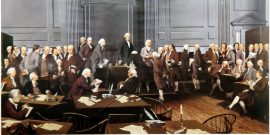"Sinking in Luxury, Sloth, and Vice"
Never in my adult lifetime has there been a greater sense of political despondency in America. This summer witnessed riots across major cities, and this winter, a riot for the first time impeded the vote-counting of the Electoral College. Domestically, polarization and partisanship are at historic highs. Abroad, a more powerful and shrewder communist adversary has emerged in China than we have ever faced before.
In Fears of a Setting Sun: The Disillusionment of America’s Founders, a magisterial survey of the Founders’ deep pessimism about the likely fate of our republic, Dennis Rasmussen brings a paradoxically optimistic message. If these wise men were so doubtful about the nation’s prospect in their own difficult times, and the nation nevertheless survived and ultimately thrived, perhaps we should become more confident about our own future. The dynamic society they bequeathed has powered on, surmounting, or at least containing, one set of dire problems after another.
Virtue, Partisanship, and Democracy
Rasmussen’s assemblage of the Founders’ profound doubts about America is creative and thought-provoking at every turn. He considers George Washington, Alexander Hamilton, John Adams, Thomas Jefferson, and James Madison. Upon leaving office, all but the last despaired of the nation which they had labored so long to create and nurture. Rasmussen sketches how each became unhappy in his own way.
George Washington feared that the rise of parties would lead to the fall of America. He had hoped to preside over a government with a unified approach to the common good, but even in his own cabinet, Hamilton and Jefferson fundamentally disagreed, and the latter soon was forming the Democratic-Republican party to oppose—first secretly and then in the open—many of Washington’s policies. Washington set forth his concerns about partisanship in his famous Farewell Address. As Rasmussen nicely points out, even his warnings there about foreign entanglements should be understood through that prism. Ideological attachments to nations abroad, whether France or Britain, created divisions at home.
But Rasmussen perhaps does not sufficiently note that the Farewell Address may have reflected Washington’s own partisan impulses. In 1796 he discarded the draft that Madison had written four years before, now that Madison had defected to the Democratic-Republican Party. For instance, the remarks on religion that Hamilton helped draft seems to echo one of the key attacks of the Federalists on Democratic-Republicans—that, like the French revolutionaries, they were deistic enemies of traditional religion and thus a danger to sound constitutional order. Rasmussen does observe that at the very end of his life Washington spoke of the Democratic-Republican Party in derogatory terms.
In his last years, Washington’s first Treasury Secretary and effective Chief of Staff Hamilton was even more despairing, saying that he was still laboring to prop up “the frail and worthless fabric of the Constitution.” Hamilton had thought the Constitution defective from the beginning because it did not provide the federal government with sufficient authority to spur the nation to greatness both commercially and militarily. But even more than the frailties of the document, he deprecated the growing democratic spirit represented by Jefferson’s party as inimical to order and public safety. Like Washington, he thought a return to religious impulse might be the nation’s only salvation.
A constitution is not a machine that goes by itself but an organism that gets life from the social and political culture around it. And that culture has been as unfriendly to our union as at any time in the modern history of the United States.
John Adams had always possessed a somewhat pessimistic cast of mind. While he had written a long defense of state constitutions as creating a satisfactory political equilibrium, he worried from the beginning that such checks and balances would not be enough to sustain a society without a virtuous citizenry. And while he was impressed by the patriotism and self-sacrifice of the American people during the revolution, he saw a radical decline in these virtues in peacetime politics: “The Nation was rising with astonishing rapidity in population and opulence and proportionally sinking in Luxury, Sloth and Vice.”
Jefferson’s concerns were unsurprisingly the flip side of Hamilton’s. If Hamilton saw the lack of energy in the federal government as a fatal defect, Jefferson worried about national consolidation of power and the resulting danger to local democracy. The worse consolidator of all was the Supreme Court under his distant cousin, John Marshall, leader of “a subtle corps of sappers and miners constantly working underground to undermine the foundations of our confederated fabric.” And while Hamilton worried about excessive democracy, Jefferson saw the spirit of commerce as aiding in this consolidation and weakening local attachments that were aids to virtue and fellow feeling.
The only major founder who was sanguine was James Madison. An important reason was that he spent much of his retirement reliving his part in founding the Constitution. He not only reorganized but revised his extensive notes of the Philadelphia Convention, as Mary Sarah Bilder has recently suggested. He was less worried about factions than Washington because he believed that the constitutional structure, particularly in the large, ever-growing republic was well designed to contain them.
Written Constitutions and the Good Society
Fears of a Setting Sun is a delightful book. Rasmussen has superbly placed the story of the Founders’ growing ideological concerns about their creation in the context of their own often eccentric personalities. Adams in particular comes across as different from the stubborn, dour character sometimes encountered in the history books. He is a wit with a self-deprecating sense of humor: “Have I not been employed in Mischief all my days? Did not the American Revolution produce the French Revolution and did not the French Revolution produce all the calamities, and the Desolations to the human race and the whole Globe ever since? I meant well however.”
Among Rasmussen’s conclusions are two of particular relevance today. First, we should take some heart from the Founders’ fears. America has gone through times so difficult that even its Founders were despondent, but it emerged still standing. There is certainly something to this confidence-building claim. Second, we should remember that, however disillusioned the Founders became, they never gave up on America and its Constitution. That message of perseverance is sound as well.
But Rasmussen does miss an opportunity to draw out a common theme of the Founders’ disparate fears, one that also has a perhaps less cheerful relevance to our day. All but Madison came to conclude that a written constitution was not enough to create a good or stable society. Also needed was an appropriate culture on which that Constitution could rest. They did not all agree on the elements of that culture. Washington emphasized the need for a certain unity of purpose that parties disturbed. Hamilton assailed an excessively democratic politics and saw commerce as a potential source of unity, whereas Jefferson saw commerce as a threat and local attachment as a bond that knits people together. Adams was a classical republican for whom virtue was key. But all agreed that while the checks and balances of a written constitution may be necessary, alone they were not sufficient.
Indeed, only Madison comes off as someone comfortable with the tenets of modern liberalism, where pluralist factions ceaselessly battle, and politics is an unending argument without any shared understanding of the common good. For the other founders, common purpose needed to be found in virtue, religion, or local bonds. Otherwise, the foundation on which any written constitution depends would not hold.
That central problem that these Founders identified has become only more acute today. The 1619 project even challenges the possibility of having a center that rests on a shared understanding of a respected past, let alone unity on common present goals. And the fragmentation that comes from social media and identity politics alike makes the divisions the Founders knew seem relatively tractable. Reading this remarkable book, I wish I could share the author’s closing sentiments. But as an older man, much like the Founders at the time Rasmussen canvasses them, I worry that there is a fundamental problem with the endurance of written constitutions, even a great one like the American Constitution.
A constitution is not a machine that goes by itself but an organism that gets life from the social and political culture around it. And that culture has been as unfriendly to our union as at any time in the modern history of the United States. That may not be an accident of the Constitution but a consequence of the liberal society it has sustained. Precisely because of its success in giving everyone the opportunity to pursue disparate goals, and now even claim distinct identities, a liberal constitution washes away the common soil, however thin, that is needed for its preservation. That we retained enough of it in the past is no guarantee that we will do so in the future.


